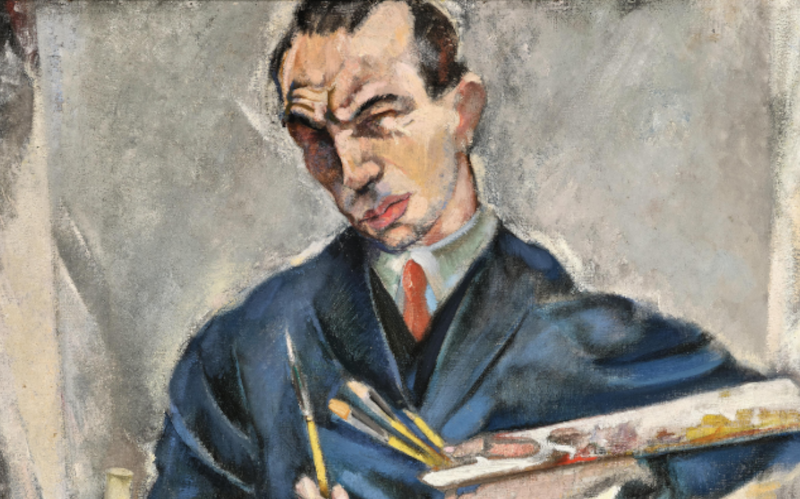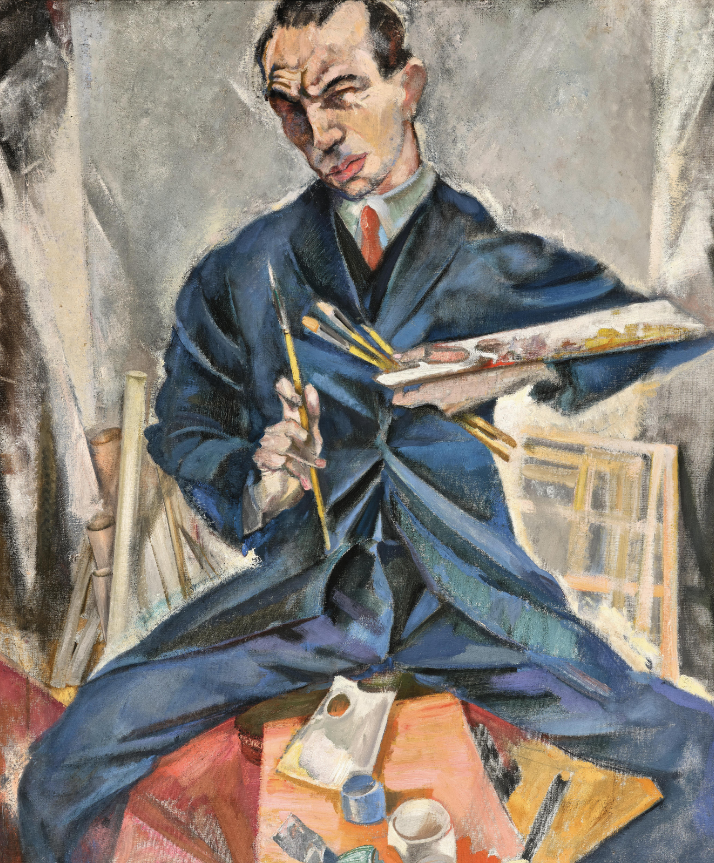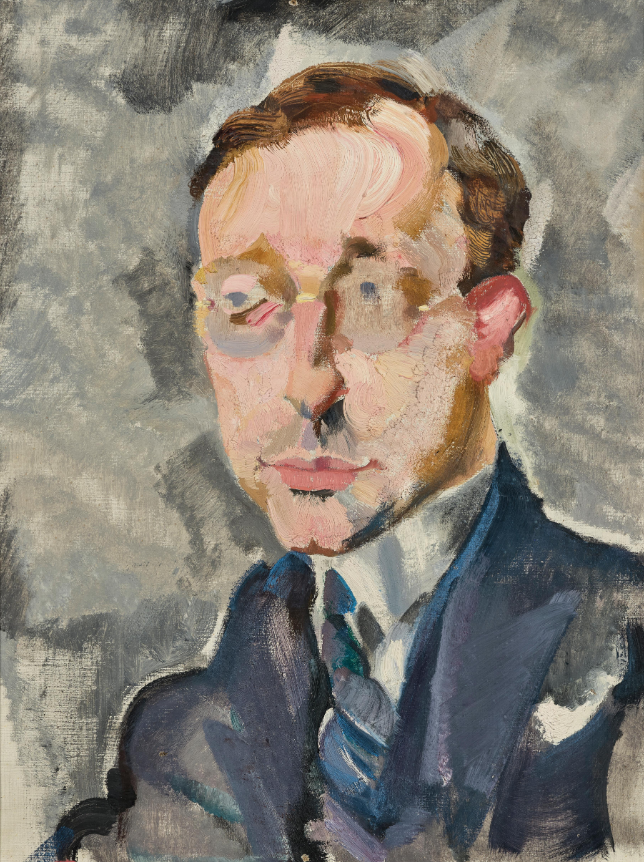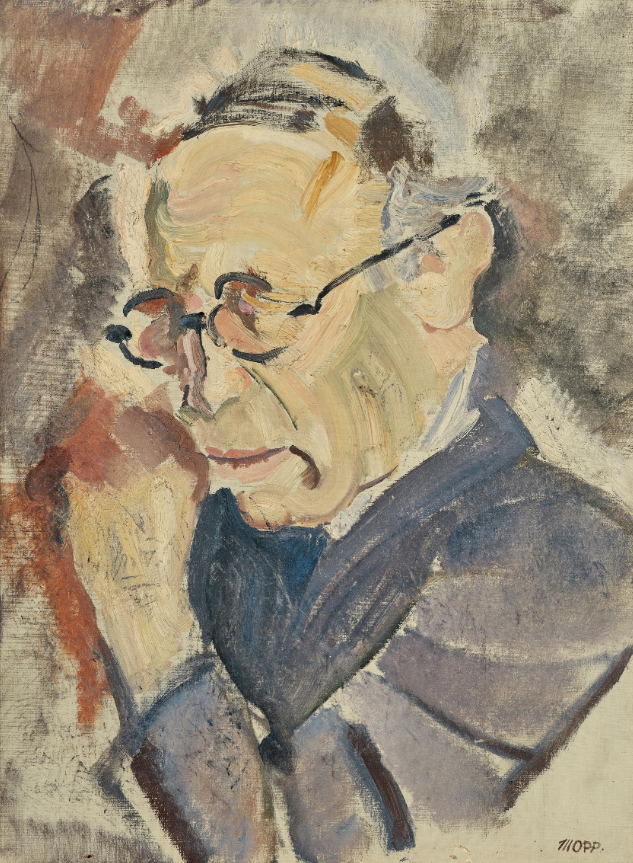
Max Oppenheimer’s self-portrait left behind in Vienna at his flight in 1938 was kept for half a century in the Wien Museum. Now, in November, after the restitution procedure, this major work by the Austrian Expressionist is being offered for sale, together with two other of his pictures.
The portrait almost explodes the frame. The spread legs fill the picture to every last corner, while the slightly inclined head in fact threatens to overlap the edge of the frame. It is as if the picture became too small for the canvas while the artist was painting it, as if his impulsive energy forced him to bring himself ever closer to the observer.
It is a self-portrait of the painter Max Oppenheimer (1885–1954), a fascinating rendering between abounding self-confidence and inner turmoil. His erect position in the centre of the picture, his arms, tense, raised aloft and bursting with vigour holding palette and brush, his one screwed-up eye – they all convey a hugely concentrated, indeed resolute presence. The colour fields fragmented into countless splinters topple this impression of security into a totering, galvanically charged chaos.
Vivisection, a medical term for the operation on the living organism, was often used in 1920s art criticism as an apt designation for the new interest in the art of deciphering the facets of a person’s psychological makeup. Without doubt, one of the masters of this merciless yet empathetic dissection of individual characteristics was the Viennese painter Max Oppenheimer. Born in 1885 as son of an editor of the Neue Freie Presse newspaper and as protagonist of late Viennese Modernism, Oppenheimer cultivated a special interest in human nature very early on.
Shortly before 1910 as connoisseur and member of the Café Central Clique in Vienna, he availed of a rich environment populated with such unusual personalities as Adolf Loos, Arthur Schnitzler, and later Heinrich and Thomas Mann, whose idiosyncrasies he had the unique opportunity to study and record.
In contrast to and quite different from his great idol Egon Schiele, he seldom opted for the self-portrait as motif; to be exact, only once per decade in the creative period prior to his emigration: in 1908, 1911, 1924, and finally in 1932. In spring of that same year he had returned from Berlin to resettle in Vienna and had moved into a studio on Neulinggasse 39 in Vienna’s 3rd district. Shrewdly, he had recognised the growing political aggression in Germany as an inescapable danger for himself as a Jewish artist. However, in Vienna he was not yet restricted in his work, and over the following six years Oppenheimer found repeated opportunities for exhibitions, sales and intensive work.
Soon after his arrival he was given the chance of a representative show in the Künstlerhaus. From November 1932 until January 1933, more than 30 oil paintings were put on show, including this one here, probably a self-portrait painted especially for the occasion, and two other portraits of Jewish personalities: Martin Hürlimann (1897–1984), who, as publisher and photographer in Zurich had founded the culture magazine Atlantis, and Moise Kogan (1879–1943), a sculptor and graphic artist from Bessarabia, who was later killed in Auschwitz in 1943. Oppenheimer outlines the essential features with broad, rapid brushstrokes; interestingly, with the mirroring spectacles and presence of head, Hürlimann’s portrait is reminiscent of the famous portrait of Thomas Mann. In contrast, the portrait of Kogan is more reduced and subtly blurred in with the painterly cloudiness of the background.
In March 1938, the night the borders were closed, Max Oppenheimer managed to flee in time to Switzerland, hence he emigrated to New York in November. Shortly afterwards his studio in Vienna was plundered; his last self-portrait and the present two portraits were part of the loot. They subsequently landed in the hands of the painter and Nazi-party member Julius Fargel who donated the works to the Vienna Municipal Collections (now Wien Museum) in February 1939. In 1994, the painting was presented in the first major retrospective of the artist’s work after the war at the Jewish Museum Vienna. Following the restitution procedure in summer to the heirs of Max Oppenheimer, two charitable organisations, all three works can be offered for sale at Dorotheum’s Auction of Modern Art in November 2024 – 70 years after Max Oppenheimer’s death on 19 May 1954.

AUCTION
Modern Art, 19 November 2024, 6 pm
Palais Dorotheum, Dorotheergasse 17, 1010 Vienna
20c.paintings@dorotheum.at
Tel. +43-1-515 60-358, 386















